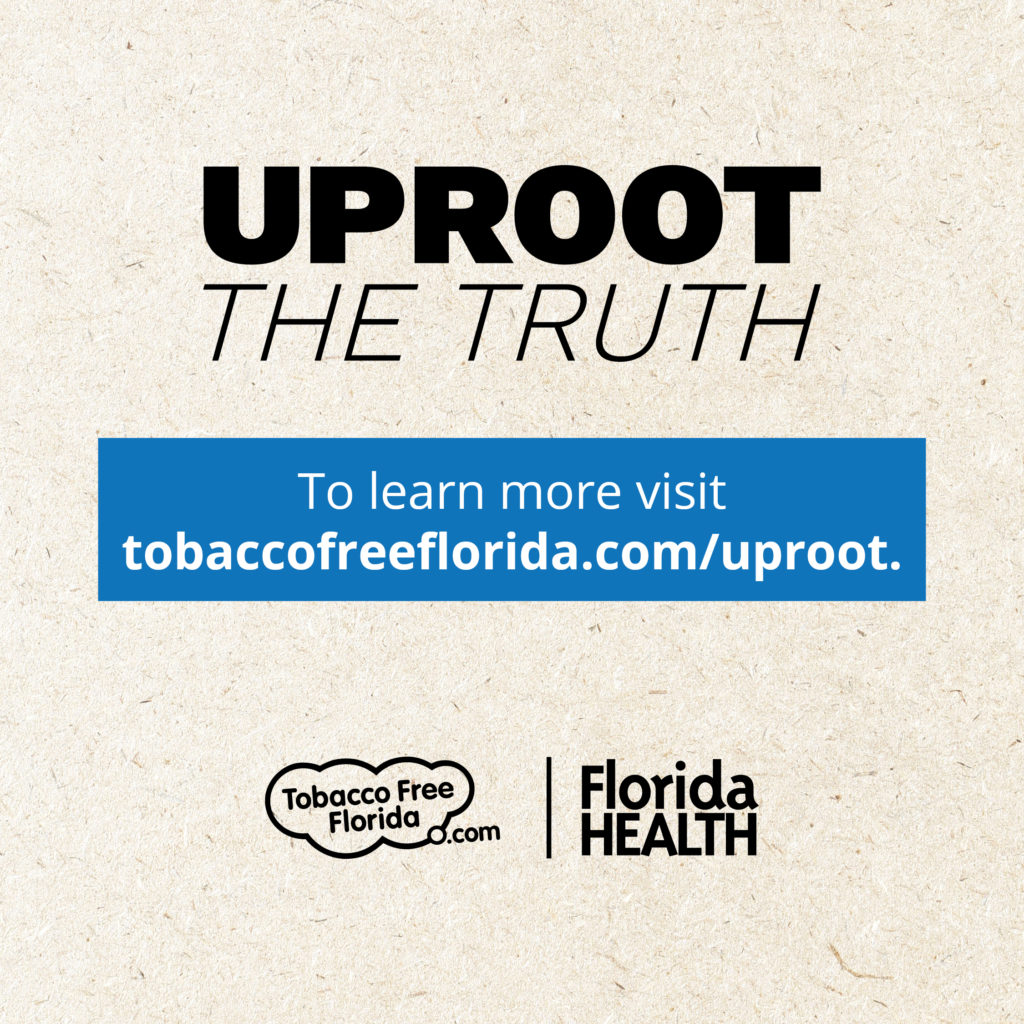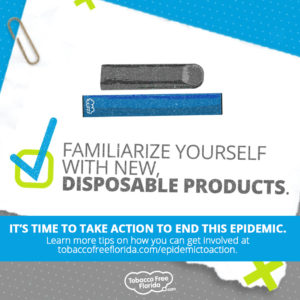E-Cigarette Epidemic: Youth and Vaping
Updated: January 17, 2024
Youth vaping, or e-cigarette use, has increased dramatically across the country and in Florida over the past few years. In September of 2019, the FDA officially declared youth vaping an epidemic and stated that flavors play an important role in driving the youth appeal. 1 In December of that same year, the U.S. Surgeon General issued an advisory, in which HHS Secretary Alex Azar stated: “In the data sets we use, we have never seen use of any substance by America’s young people rise as rapidly as e-cigarette use is rising.” 2
Along with the increased concern, there is also confusion and misinformation around the topic. The Bureau of Tobacco Free Florida is a trusted resource for credible and accurate information about the youth vaping epidemic. Here’s what we know:
Learn the Facts
E-cigarette companies claim that their products are intended for adults, but skyrocketing rates among teens tell a different story. In 2023, 12.5% of Florida high school students reported current e-cigarette use. 3 Meanwhile, in 2022, 8.8% of Florida adults used e-cigarettes. 4 Although the youth e-cigarette rates have decreased in recent years, there is still much work to do to combat this epidemic.
At the beginning of the epidemic, the most popular e-cigarette brand was JUUL, 5 a device shaped like a USB flash drive. The JUUL comes in a variety of flavors, delivers high levels of nicotine, 6 and is easy to conceal. 7, 8 News outlets and social media sites reported widespread use of JUUL by students in schools, including in classrooms and bathrooms. 9
In December 2018, Marlboro cigarette maker Altria purchased a 35% stake in JUUL for $12.8 billion. 10 The company went from 2% market share in 2016 to 76% market share by the end of 2018. 11, 12, 13 Other manufacturers, including tobacco companies, have recently started making similar devices. R.J. Reynolds (RJR), the makers of Newport and Camel, and Imperial Brands, the makers of Winston and Kool, have launched similar devices that also resemble a USB drive. 14, 15
Recently, popular disposable e-cigarettes have also flooded the market. These newer brands, such as Puff Bar and HDQs, are available in a variety of flavors and deliver high levels of nicotine.
We do not know what the tobacco companies’ involvement means for the future of e-cigarettes. But we do know that they cannot be trusted. In a landmark 2006 judgement, a U.S District Judge found that the major U.S. tobacco companies violated civil racketeering laws (RICO) for conspiring over decades to deceive the American public about the health effects of smoking, the addictiveness of nicotine, and their marketing to youth.16
Know the Risks
E-cigarettes typically contain nicotine, which is highly addictive. 17 Teens may be more sensitive to nicotine and feel dependent on nicotine sooner than adults. 18, 19, 20
A single JUUL pod (the liquid nicotine refill) contains as much nicotine as a pack of 20 regular cigarettes. 21 JUUL uses nicotine salts, which can allow high levels of nicotine to be inhaled more easily and with less irritation.22
The brain continues to develop until about age 25 and the developing brain is more vulnerable to nicotine’s effects, including reduced impulse control, deficits in attention and cognition, and mood disorders. 23 Evidence suggests that teens who use e-cigarettes may be at greater risk of starting to smoke regular cigarettes. 24, 25, 26, 27
While the long-term health effects of e-cigarettes are still unknown, some of the ingredients in e-cigarette aerosol could be harmful to your lungs. For example, some e-cigarette flavorings may be safe to eat but not to inhale because the gut can process more substances than the lungs. 28, 29
E-cigarette aerosol – aka vapor – is not harmless “water vapor,” as many youths mistakenly believe. 30 The aerosol that users breathe from an e-cigarette device and exhale may contain harmful substances including cancer-causing chemicals and heavy metals such as nickel, tin, and lead. 31
Get Informed
Florida has always been at the forefront of tobacco prevention. Today, fewer teens than ever are smoking regular cigarettes. 32 We cannot allow Big Tobacco, an industry that lied to the public for decades, to erase this progress.
Getting accurate information about the youth vaping epidemic into the hands of our citizens is the first step to reverse the alarming trends. You can help by educating yourself, dispelling myths among your friends and family, and talking to your kids or your students about the serious concerns around vaping and nicotine addiction.
Infographic
Vaping and Youth
Fact Sheet
Vaping and Youth
Florida Youth Tobacco Survey
1 FDA Statement. “Statement from FDA Commissioner Scott Gottlieb, M.D., on new steps to address epidemic of youth e-cigarette use.” U.S. Food and Drug Administration. 12 Sept. 2018 www.fda.gov/NewsEvents/Newsroom/PressAnnouncements/ucm620185.htm (Accessed 24 July 2019)
2 U.S. Department of Health & Human Services. “Surgeon General releases advisory on E-cigarette epidemic among youth.” 18 Dec. 2018. www.hhs.gov/about/news/2018/12/18/surgeon-general-releases-advisory-e-cigarette-epidemic-among-youth.html (Accessed 24 July 2019)
3 Florida Department of Health. Florida Youth Tobacco Survey. 2023. Accessed January 11, 2024
4 Centers for Disease Control and Prevention, National Center for Chronic Disease Prevention and Health Promotion, Division of Population Health. 2019 Florida Behavioral Risk Factor Surveillance System (BRFSS) Data Book. Accessed February 5, 2021
5 Craver, Richard. “Juul ends 2018 with 76 percent market share.” Winston-Salem Journal. 8 Jan. 2019. www.journalnow.com/business/juul-ends-with-percent-market-share/article_6f50f427-19ec-50be-8b0c-d3df18d08759.html (Accessed 24 July 2019)
6 CDC Newsroom Releases. “Sales of JUUL e-cigarettes skyrocket, posing danger to youth.” Centers for Disease Control and Prevention (CDC). 2 Oct. 2018. https://www.cdc.gov/media/releases/2018/p1002-e-Cigarettes-sales-danger-youth.html (Accessed 24 July 2019)
7 Truth Initiative. “Nearly 1 in 5 youth say they have seen JUUL used in school.” 23 May 2018. truthinitiative.org/news/nearly-1-5-youth-say-they-have-seen-juul-used-school (Accessed 24 July 2019)
8 Zernike, Kate. “‘I Can’t Stop’: Schools Struggle With Vaping Explosion.” The New York Times. 2 April 2018. www.nytimes.com/2018/04/02/health/vaping-ecigarettes-addiction-teen.html (Accessed 24 July 2019)
9 Centers for Disease Control and Prevention (CDC). “Quick Facts on the Risks of E-cigarettes for Kids, Teens, and Young Adults.” CDC Office on Smoking and Health, National Center for Chronic Disease Prevention and Health Promotion. 3 Dec 2018. www.cdc.gov/tobacco/basic_information/e-cigarettes/Quick-Facts-on-the-Risks-of-E-cigarettes-for-Kids-Teens-and-Young-Adults.html (Accessed 24 July 2019)
10 Kirkham, Chris. “Altria to Buy $12.8 Billion Minority Stake in E-cigarette Company Juul.” Reuters. 20 Dec. 2018. www.reuters.com/article/us-juul-altriagroup-m-a/altria-to-buy-12-8-billion-minority-stake-in-e-cigarette-company-juul-idUSKCN1OJ1JS (Accessed 24 July 2019)
11 Craver, Richard. “Juul ends 2018 with 76 percent market share.” Winston-Salem Journal. 8 Jan. 2019. www.journalnow.com/business/juul-ends-with-percent-market-share/article_6f50f427-19ec-50be-8b0c-d3df18d08759.html (Accessed 24 July 2019)
12 King BA, Gammon DG, Marynak KL, Rogers T. Electronic Cigarette Sales in the United States, 2013-2017. JAMA. 2018;320(13):1379–1380. doi:10.1001/jama.2018.10488
13 CDC Newsroom Releases. “Sales of JUUL e-cigarettes skyrocket, posing danger to youth.” Centers for Disease Control and Prevention (CDC). 2 Oct. 2018. https://www.cdc.gov/media/releases/2018/p1002-e-Cigarettes-sales-danger-youth.html (Accessed 24 July 2019)
14 Kirkham, Chris. “Special Report: Juul copycats flood e-cig market, despite FDA rule.” Reuters. 24 Sept. 2018. www.reuters.com/article/us-vaping-regulation-juul-specialreport/special-report-juul-copycats-flood-e-cig-market-despite-fda-rule-idUSKCN1M418W (Accessed 24 July 2019)
15 Craver, Richard. “Reynolds Vapor prepares national launch of new e-cig rival to Juul.” Winston-Salem Journal. 17 July 2018. www.journalnow.com/business/reynolds-vapor-prepares-national-launch-of-new-e-cig-rival/article_7ba10442-d438-575e-af23-794173089a8a.html (Accessed 24 July 2019)
16 USA v. Philip Morris, USA, Inc., et al. (Civil Action No. 99-2496 (GK), August 17, 2006).
17 U.S. Department of Health and Human Services. E-Cigarette Use Among Youth and Young Adults. A Report of the Surgeon General. Atlanta, GA: U.S. Department of Health and Human Services, Centers for Disease Control and Prevention, National Center for Chronic Disease Prevention and Health Promotion, Office on Smoking and Health, 2016.
18 U.S. Department of Health and Human Services. E-Cigarette Use Among Youth and Young Adults. A Report of the Surgeon General. Atlanta, GA: U.S. Department of Health and Human Services, Centers for Disease Control and Prevention, National Center for Chronic Disease Prevention and Health Promotion, Office on Smoking and Health, 2016.
19 U.S. Department of Health and Human Services. The Health Consequences of Smoking: 50 Years of Progress. A Report of the Surgeon General. Atlanta, GA: U.S. Department of Health and Human Services, Centers for Disease Control and Prevention, National Center for Chronic Disease Prevention and Health Promotion, Office on Smoking and Health, 2014. Printed with corrections, January 2014.
20 U.S. Department of Health and Human Services. Preventing Tobacco Use Among Youth and Young Adults: A Report of the Surgeon General. Atlanta, GA: U.S. Department of Health and Human Services, Centers for Disease Control and Prevention, National Center for Chronic Disease Prevention and Health Promotion, Office on Smoking and Health, 2012.
21 Centers for Disease Control and Prevention (CDC). “E-cigarettes Shaped Like USB Flash Drives: Information for Parents, Educators and Health Care Providers.” CDC Office on Smoking and Health, National Center for Chronic Disease Prevention and Health Promotion. 18 Oct. 2018. www.cdc.gov/tobacco/basic_information/e-cigarettes/factsheet/index.html (Accessed 11 March 2019)
22 CDC Newsroom Releases. “Sales of JUUL e-cigarettes skyrocket, posing danger to youth.” Centers for Disease Control and Prevention (CDC). 2 Oct. 2018. https://www.cdc.gov/media/releases/2018/p1002-e-Cigarettes-sales-danger-youth.html (Accessed 24 July 2019)
23 U.S. Department of Health and Human Services. E-Cigarette Use Among Youth and Young Adults. A Report of the Surgeon General. Atlanta, GA: U.S. Department of Health and Human Services, Centers for Disease Control and Prevention, National Center for Chronic Disease Prevention and Health Promotion, Office on Smoking and Health, 2016.
24 Berry KM, Fetterman JL, Benjamin EJ, et al. Association of Electronic Cigarette Use With Subsequent Initiation of Tobacco Cigarettes in US Youths. JAMA Netw Open. 2019;2(2):e187794. doi:10.1001/jamanetworkopen.2018.7794
25 Miech R, Patrick ME, O’Malley PM, et al E-cigarette use as a predictor of cigarette smoking: results from a 1-year follow-up of a national sample of 12th grade students Tobacco Control 2017;26:e106-e111.
26 National Academies of Sciences, Engineering, and Medicine. 2018. Public Health Consequences of E-Cigarettes. Washington, DC: The National Academies Press. https://doi.org/10.17226/24952.
27 U.S. Department of Health and Human Services. E-Cigarette Use Among Youth and Young Adults. A Report of the Surgeon General. Atlanta, GA: U.S. Department of Health and Human Services, Centers for Disease Control and Prevention, National Center for Chronic Disease Prevention and Health Promotion, Office on Smoking and Health, 2016.
28 Centers for Disease Control and Prevention (CDC). “Quick Facts on the Risks of E-cigarettes for Kids, Teens, and Young Adults.” CDC Office on Smoking and Health, National Center for Chronic Disease Prevention and Health Promotion. 3 Dec 2018. www.cdc.gov/tobacco/basic_information/e-cigarettes/Quick-Facts-on-the-Risks-of-E-cigarettes-for-Kids-Teens-and-Young-Adults.html (Accessed 24 July 2019)
29 U.S. Department of Health and Human Services. E-Cigarette Use Among Youth and Young Adults. A Report of the Surgeon General. Atlanta, GA: U.S. Department of Health and Human Services, Centers for Disease Control and Prevention, National Center for Chronic Disease Prevention and Health Promotion, Office on Smoking and Health, 2016.
30 Centers for Disease Control and Prevention (CDC). “Quick Facts on the Risks of E-cigarettes for Kids, Teens, and Young Adults.” CDC Office on Smoking and Health, National Center for Chronic Disease Prevention and Health Promotion. 3 Dec 2018. www.cdc.gov/tobacco/basic_information/e-cigarettes/Quick-Facts-on-the-Risks-of-E-cigarettes-for-Kids-Teens-and-Young-Adults.html (Accessed 24 July 2019)
31 US Department of Health and Human Services. E-cigarette Use Among Youth and Young Adults: A Report of the Surgeon General. Atlanta, GA: US Department of Health and Human Services, CDC; 2016. Accessed July 27, 2018.
32 Florida Youth Tobacco Survey (FYTS), Florida Department of Health, Bureau of Epidemiology, 2023. Accessed January 11, 2024




















